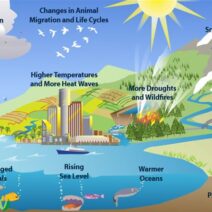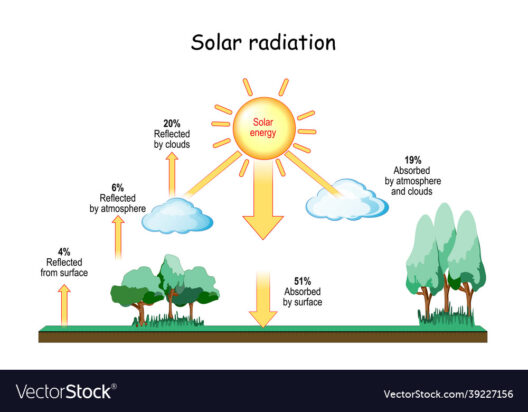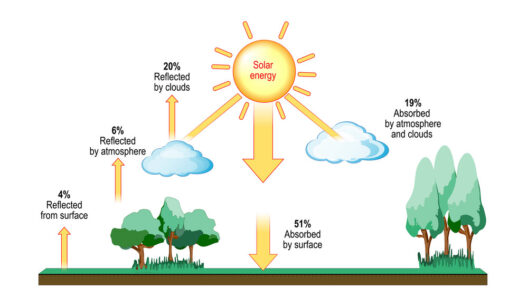The world’s climate stands as a complex tapestry woven from several threads, each contributing uniquely to the fabric of our atmospheric conditions. While countless elements intertwine to shape weather patterns and climatic phenomena, four primary factors emerge as the keystones of climatic influence: solar radiation, atmospheric circulation, ocean currents, and topography. Understanding these components is crucial for grasping how they mold our planet’s diverse climatic zones.
First and foremost is solar radiation, the celestial essence bestowed upon Earth by our sun. It acts as the driving force behind virtually all climate systems. This energy, in varying intensities based on geographic location and time of year, orchestrates the rhythm of climate cycles. The equator acts as a warm embrace, receiving direct sunlight year-round, while the poles endure a prolonged winter’s night, resulting in vast climatic contrasts. This disparity creates a palpable gradient between warmer tropical climates and the frigid polar realms, akin to an artist’s brushstrokes painting distinct colors on a canvas.
Your experience of warmth or chill can often be attributed to the angle at which sunlight strikes the Earth. During summer, the sun arcs high in the sky, pouring its rays with fervor, while in winter, it lingers low, casting a softer glow. As a result, regions are delineated not only by temperature but by the vegetative tapestry they support. From the rich rainforests thriving in the tropics to the austere tundras blanketing the Arctic, the influence of solar radiation is paramount, shaping biodiversity and ecosystems across the globe.
Next, we must navigate the expansive currents of atmospheric circulation — the great highways of the sky. These sprawling air movements arise from differences in temperature and pressure across the Earth’s surface. The Coriolis effect, a consequence of the Earth’s rotation, plays an instrumental role in directing these currents, creating a swirling symphony of wind patterns that dictate weather systems. Think of the atmosphere as a grand orchestra, where each note corresponds to a vital wind pattern, influencing everything from precipitation to temperature swings.
The equatorial regions, under the solar spotlight, heat the air, causing it to rise. This ascent creates a low-pressure zone, drawing in cooler, denser air from surrounding areas. As this cool air succumbs to the warmth, it too ascends, perpetuating a cycle of rising and falling air masses. The resultant trade winds and westerlies dictate not just local weather patterns but also the migration of storms across oceans and continents. This complexity underscores the interconnectedness of global weather systems; what begins as a gentle breeze on one hemisphere may culminate in tempestuous gales half a world away.
Transitioning from the ethereal winds to the depths of the ocean, we encounter ocean currents, another monumental factor that governs climate. These currents, much like vast rivers beneath the sea, transport warm and cold water across great distances, playing a pivotal role in regulating global temperatures. The Gulf Stream, for instance, sweeps warm water from the tropical Caribbean northward toward Europe, bestowing milder winters on the continent. Without this clandestine flow of warmth, entire regions might descend into biting cold, akin to a chilling hand gripping the land.
The dance between ocean currents and atmospheric patterns is a delicate balance. Warm waters rise, instigating evaporation and consequently altering atmospheric pressure, which manifests as climate phenomena. El Niño and La Niña are testament to this interplay, where shifts in sea surface temperatures can lead to widespread weather alterations, exemplifying the cascade effect that emanates from altered oceanic currents. One change begets another, rippling through the climate like a stone dropped into a still pond, unsettling the surface and consequences far beyond its origin.
Finally, the fourth key factor influencing climate is topography, the intricate ruggedness of Earth’s surface. Mountain ranges, valleys, and plateaus act as formidable barriers, dictating wind patterns and precipitation distribution. The presence of mountains can create rain shadows, where one side receives ample rainfall while the other languishes in drought. This phenomenon can transform lush landscapes into arid expanses in a matter of miles, painting a vivid contrast in the environment — a vivid reminder of nature’s ability to sculpt the land in its image.
Take, for example, the Himalayas, which act as a colossal barrier to monsoon winds moving from the Indian Ocean. Their heights foster cloud formation, leading to torrential rains on the southern slopes, while the northern regions remain parched, devoid of moisture. In this sense, topographical features are not mere land formations but active participants in the climate narrative, directing moisture and temperature in time-honored patterns seen through millennia.
Thus, pondering the factors that shape climate leads to a deeper understanding of the Earth’s climatic tapestry. Solar radiation bathes our planet in life-sustaining warmth, atmospheric circulation channels this energy through the winds, ocean currents moderate temperatures and precipitation, while topography intricately molds our landscapes and their climates. Together, these elements orchestrate the symphony of weather we experience daily. They remind us of the delicate balance within which life flourishes and the profound responsibility we hold as stewards of this intricate system.
In the face of climate change, the wisdom gleaned from these insights becomes even more paramount. Our actions can forge a decision-making path that aligns with nature’s rhythms rather than disrupting them. Recognizing and respecting these four major climatic factors is vital as humanity navigates its relationship with the planet. Every decision, every policy, and every effort toward sustainability can serve as a note in the symphonic masterpiece that is our shared home. Harnessing knowledge to foster understanding is the first step toward fostering harmony with the forces that shape our climate.








